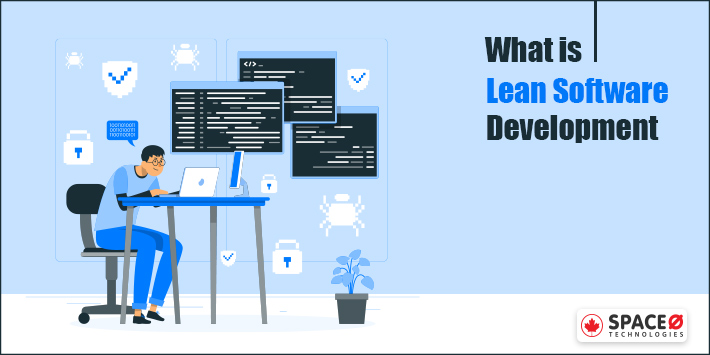In this technology-driven world, anyone with an Internet connection and an idea can build an audience and a business out of it.
In such a data-driven era, it isn’t uncommon that most of the revolutionary companies or innovative breakthroughs of our times are all Internet/SaaS-based.
In this article, we will discuss one such groundbreaking concept that has reshaped the IT industry and contributed to the success of many companies we see today. Almost all top software development companies use different types of top software development methodologies to create software as per requirements.
Table of Contents
What is Lean Software Development (LSD)?
Lean Software Development is an agile framework. It focuses on optimizing the development time and resources, eliminating unnecessary procedures and functions, and delivering only that version of the products, which meets the customers’ core demands.
The methodology aims at removing the fluff – all that’s unnecessary, from the software engineering process.
You might also know this concept as a minimum viable product or MVP strategy.
Both are termed differently but share similar goals and procedures.
- Minimum viable product is when the development team releases a prototype version of the software/product into the market
- Its behavior is then analyzed from the product metrics
- Important factors are noted
- Flaws and errors are rectified
- And better updates are rolled out again until the prototype fulfills all the requirements of the customers
This minimalistic yet systematic and efficient design of a product based on optimization, elimination, and consistent iterations (depending on the market metrics), is known as Lean Software Development.
The principles, as you will see, are largely similar to that of Agile software development. No doubt why some regard the two technologies as inter-linked. Others believe that the Lean development strategy converges better.
We, however, stick to the principles point of view of Lean Software Development, all of which aim to speed up the delivery and extend high value to the end-user. The below lean principles are the best practices to make your product rule over the market.
Know how lean software development will benefit your business.
Get in touch with our experts and let them guide you!

7 Principles of Lean Software Development

Here are the seven lean development principles –
Eliminate Waste
Waste, here, comprises useless features and codebase, unclear requirements, delays, ineffective communication, task overload, quality issues, hampering bureaucracy, duplication of data, and the associated costs of the given. It’s one of the best practices as it reduces your lots of blocks for further continuous improvement.
Build Quality
Quality is ensured through flexible engineering, instant assessment of the iteration cycles/loops, time reduction between software development stages, and regular consideration of time/costs/scope. Use of the latest software development technology and trends to reduce development efforts and make futuristic software.
Amplify Knowledge
Instant reflection on codes during iterations quickly highlights the lessons learned and amplifies the knowledge. Pair programming is preferred to avoid knowledge accumulation with one software engineer. Code reviews, meetings, feedback, optimization further amplify the learning process.
Delay Commitment
Lean Software Development keeps postponing irreversible decisions. It does so until all experiments are conducted, all information is successfully gathered, and all the requirements are thoroughly checked.
Deliver Fast
Unlike the traditional software development practices, where software engineers entered the software market when each part of the strategy was worked upon, and milestones were reached, Lean Software Development follows the MVP strategy.
This strategy promotes building quickly, including some functionality, and launching the product in the software market as soon as possible. And finally, studying the reaction to understand what’s important and what’s unnecessary.
Respect Involved Human Resource
Contrary to the traditional popular software development methodologies, and similar to Agile software development, Lean Software Development methodology focuses on empowering the product teams rather than controlling them.
The goal is to grant enough freedom and flexibility to engineers and developers to make independent decisions.
Keep Optimizing the Entire Process
Lean Software Development methodology promotes unity among project managers/teams of developers involved in the project. It also highlights shared objectives and responsibilities and ultimately leads to high performance.
The DevOps methodology also shares the same principles as Lean. If you want to read more about Devops methodology then we have written a dedicated blog on DevOps software development methodology.
Lean Software Development aims to fulfill these integrity-filled principles by leveraging the following tools –
- Inventory management – Aimed to reduce the in-progress operations that are taking place simultaneously. How? Through applying constraints theory and queuing theory.
- Kanban – Aimed to limit simultaneously completed tasks to prevent overloading the process of development.
- Mapping the value stream – Value stream mapping is visualizing the development cycle. The visualization begins at the client’s request and goes on to the deployment stage. It is aimed to determine and optimize the whole waiting and processing time.
History of Lean Software Development (LSD)
At its nascent stage, this mindblowing methodology wasn’t known as Lean Software Development.
It was called the “Toyota production system.”
As confusing as the Toyota production system may sound, it’s a well-known fact that this technique’s roots go back to the mid-twentieth century. And was initiated by the popular car manufacturer Toyota.
Toyota invented this approach to streamline its production of cars, eliminate waste, and all that didn’t directly contribute to the production.
Any action that didn’t directly impact the car’s functionality on a holistic level was considered a waste under this system and was removed from the production process.
Eventually, Toyota cars’ massive success in the market, followed by the implementation of the technique, caught major industries’ attention.
By the end of the 20th century, most automobile companies had adopted this methodology into their production system. And by the 21st century, Lean development found its way into the internet world.
Lean Software Development was first applied in the creation of software in 2003, the same year in which the highly popular book “Lean Software Development” was published.
With the use of lean development methodology, you can improve your product design, product development with better product management.
Pros and Cons of Lean Software Development
Just like the twin sides of a coin, this ground-breaking concept comes with pros and cons.

Let’s analyze its merits and demerits before we elaborate on how this concept is beneficial to all industries worldwide.
Advantages of Lean Software Development
Streamlined Approach
Lean Software Development reduces the unnecessary stages and procedures from the planning phase to the design, programming, and output phase. Any action within the above, that doesn’t directly affect the overall functionality is removed from the software. This saves a lot of time in product development and valuable resources for the team, focusing on other pressing requirements.
Eliminates Loss
Lean permanently avoids any loopholes or chances of loss by eliminating useless procedures and processes due to needless activities. Thus, the activities that might cost a huge amount to the organization/developer are cut off and increase the business value.
Early Delivery
Software designed using the LSD instruction is created and delivered within an incredibly short duration of time, compared to the conventional software designing models. Thus, the project manager can offer the delivery easily.
Optimized Workflow
LSD encourages active participation and decision-making of the development team at each step of the process.
By increasing participation, the overall workflow gets optimized and a linear approach is implemented, which results in quick and earlier delivery and lower loss of any kind for the organization/developer.
Disadvantages of Lean Software Development
Scope of Scalability
The project is highly dependent on the cohesiveness of the team and the individual commitments of the team members. Therefore, it isn’t possible to scale at a higher rate as compared to conventional software design frameworks.
Strong Documentation
Lean Software Development is a step-by-step process, designed using precise, accurate data in each step. It is, thus, highly important that each step is documented without fail.
Failure to do the same can result in developmental errors. This might also backfire as extended time and surplus resource requirement compared to what was decided.
Flexibility
In lean manufacturing, you allow the software requirements specification (SRS) to evolve. However, this causes problems of its own. Flexibility is great, but too much of it sometimes leads to a development that loses sight of its original objectives and never finishes.
With that said, most tech giants still leverage the Lean Software Development process in their design phase. Because they have concluded that its pros outweigh the cons on any given day.
From a general perspective, LSD streamlines the design progress, improves the team’s confidence on a holistic level, and focuses on the most essential features required to bring customer value to the end-users. However, another method like the spiral model helps to build a project carefully which consists of high risks.
Moreover, most organizations often blend the elements of multiple methods to use a hybrid approach which helps them to achieve their different goals including quality, faster deployment, and allowing them to achieve more flexible scalability.
So, if you are looking to learn more about the spiral model, read our detailed blog post on the spiral model of software development.
Benefits of Lean Software Development
Efficiency has never been more important to the software Industry than it is now.
The higher cost of extended input time and a multitude of resource requirements have placed many developers/companies at a competitive disadvantage. This happens even after having a foolproof idea that could turn out to be a revolution of tomorrow.

Lean Software Development is one of few such software development methodologies that can solve efficiency – at low cost, fewer resources, and reduced time.
Let’s discuss in detail how LSD is equally beneficial to both corporates and developers –
Enhanced product quality
Efficient processing frees resources and employees.
Thus, resources are used optimally and promptly, which otherwise would have been of zero use to the organization’s overall growth.
They are then invested in and assigned to other innovative activities which result in enhanced product quality.
Sustainable Future
More streamlined stages of production, less usage of time and resources, and all of the above make a company that takes sustainable development seriously.
In other words, LSD brings up a company that does not misuse the allocated resources and whose functions contribute to economic development in some form.
These are, in fact, the initial steps for a company/software firm to ace competition for years to come.
Employee satisfaction & loyalty
Contrary to the common perception, employees quickly realize when their daily routine is bloated with useless work. Or even worse, when they have to work overtime for a task that’s done for the sake of it and does not directly contribute to the software’s functions in any way.
This terribly affects employee morale.
But with the lean approach in action, the software development teams focus on work that serves a purpose. The teams, thus, feel an innate satisfaction in performing a given task.
Therefore, Lean development boosts employee productivity and plays a crucial role in employee satisfaction and loyalty.
Increased Profits
This is an obvious and definitive result that follows up once you implement the Lean Software Development. Increased productivity, reduced waste, and better quality will undeniably bring you profit showers.
Do you want to know how it benefits your business?
Get in touch with us, and our technical experts will guide you further.
Frequently Asked Questions
What is the lean methodology of software development?
Often referred to as a Minimum viable product (MVP) strategy, the lean methodology is a series of steps to eliminate resource wastage or unrequired labor while maintaining an increased level of production.
Lean Software Development is a net improvement in total efficiency, productivity, and better build quality of the software.
What are the principles of Lean Software Development?
Mary Poppendieck and Tom Poppendieck were the first people who applied Lean development in the software field.
Mary Poppendieck also outlined 7 major principles that determine the successful implementation of Lean Software Development.
They are as follows –
- Eliminate Waste
- Build Quality
- Amplify Knowledge
- Delay commitment
- Deliver fast
- Respect involved human resource
- Keep optimizing the process
How many team members are required for a Lean Software Development team?
There are around 10 – 15 members in the lean development team.
They are divided based on 3 significant roles in the lean development process.- Lean master – Coaches, trains, and mentors individuals in lean management.
- Lean project leaders – The lean project leaders work mainly as communication channels between the lean master and the team but also work as a motivator.
- Lean team – An individuals team member who works together to design and implement the solution.
Conclusion
That was all about the Lean software development methodology. As we see, the approach promotes a customer-first outlook and induces flexibility in the otherwise rigid development system. By now, we realize that it is not the processes or tools but the teams and their decisions that makes a methodology successful.
So that’s the kind of integrity and expertise you need when zeroing in on the custom software development company. You essentially need a team of highly committed professionals to your project and are determined to extend high quality in the least time.
 By
By 





